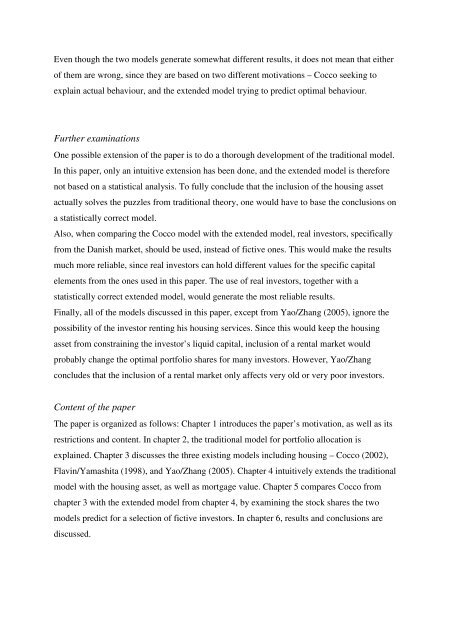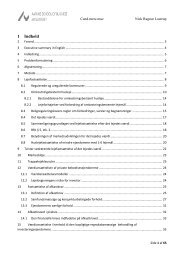Den langsigtede investors optimale porteføljevalg med ... - DN Erhverv
Den langsigtede investors optimale porteføljevalg med ... - DN Erhverv
Den langsigtede investors optimale porteføljevalg med ... - DN Erhverv
You also want an ePaper? Increase the reach of your titles
YUMPU automatically turns print PDFs into web optimized ePapers that Google loves.
Even though the two models generate somewhat different results, it does not mean that either<br />
of them are wrong, since they are based on two different motivations – Cocco seeking to<br />
explain actual behaviour, and the extended model trying to predict optimal behaviour.<br />
Further examinations<br />
One possible extension of the paper is to do a thorough development of the traditional model.<br />
In this paper, only an intuitive extension has been done, and the extended model is therefore<br />
not based on a statistical analysis. To fully conclude that the inclusion of the housing asset<br />
actually solves the puzzles from traditional theory, one would have to base the conclusions on<br />
a statistically correct model.<br />
Also, when comparing the Cocco model with the extended model, real <strong>investors</strong>, specifically<br />
from the Danish market, should be used, instead of fictive ones. This would make the results<br />
much more reliable, since real <strong>investors</strong> can hold different values for the specific capital<br />
elements from the ones used in this paper. The use of real <strong>investors</strong>, together with a<br />
statistically correct extended model, would generate the most reliable results.<br />
Finally, all of the models discussed in this paper, except from Yao/Zhang (2005), ignore the<br />
possibility of the investor renting his housing services. Since this would keep the housing<br />
asset from constraining the investor’s liquid capital, inclusion of a rental market would<br />
probably change the optimal portfolio shares for many <strong>investors</strong>. However, Yao/Zhang<br />
concludes that the inclusion of a rental market only affects very old or very poor <strong>investors</strong>.<br />
Content of the paper<br />
The paper is organized as follows: Chapter 1 introduces the paper’s motivation, as well as its<br />
restrictions and content. In chapter 2, the traditional model for portfolio allocation is<br />
explained. Chapter 3 discusses the three existing models including housing – Cocco (2002),<br />
Flavin/Yamashita (1998), and Yao/Zhang (2005). Chapter 4 intuitively extends the traditional<br />
model with the housing asset, as well as mortgage value. Chapter 5 compares Cocco from<br />
chapter 3 with the extended model from chapter 4, by examining the stock shares the two<br />
models predict for a selection of fictive <strong>investors</strong>. In chapter 6, results and conclusions are<br />
discussed.




